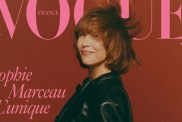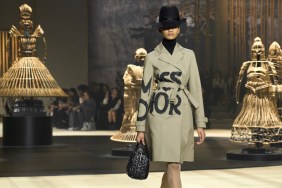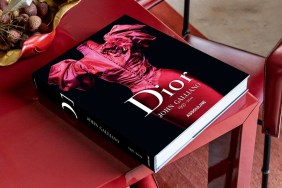
Alexis Bittar discussing his design process.

The 2010 CFDA Accessory Designer of the Year started off by giving us a little background on the material. Originally created by DuPont, commercial production of Lucite began in 1936. During World War II it was used for submarine periscopes, windshields, and canopies, as well as gun turrets for airplanes. It wasn’t until the 1950s that it began to make its way into handbag, jewelry, and furniture design. As for Bittar, he’s been using Lucite to craft creations since the inception of his brand over 20 years ago. Today, Bittar designs three distinctive lines: Elements, Miss Havisham, and Lucite the latter of which makes up 60% of his business.

Interestingly enough, Bittar can trace his passion for jewelry back to his early childhood, and he showed us photo evidence to prove it! When he was 8 years old he began selling jewelry on the street and at 13 he was a regular selling antique pieces on St. Mark’s. Bittar is completely self-taught and traces his unique aesthetic back to his love of antique jewelry, which ties into his affinity for Lucite. Each of his Lucite pieces are hand-carved, something that no one was doing at the time he began his career. When Bittar launched his brand in the early 1990s, his work was a marked difference from the minimalist trend that was going on; in fact when the designer first sold his Lucite creations on the street – on Mercer and Prince to be exact – his pieces were so unique that they caught the eyes of influential museum buyers who couldn’t believe one could fashion such covetable designs out of plastic. It wasn’t long before Alexis Bittar was being stocked at the Museum of Modern Art, Bergdorf Goodman, and Harrod’s.

When asked about the appeal of Lucite, Bittar remarked that he “loves Lucite because it’s modern and futuristic at the same time,” adding that the biggest misconception people have about the material is that it’s cheap. “It’s the platinum of plastics because if you decide to use an injection mold, it costs about $12,000 per mold and the other option [the one Bittar opts for] is hand sculpting, so it’s not an easy thing for a young designer to jump into,” the designer noted.
Bittar has crafted an innumerable amount of impressive pieces with Lucite including interpreting Burberry’s signature plaid, outfitting the Spring 2008 and Spring 2010 Michael Kors shows with Lucite jewelry, working with Jason Wu for Spring 2011, and so much more.

In a nod to how creative Bittar is and how versatile the material can be, Bittar showed us a slew of celebrity images with stars outfitted in his designs including Michelle Obama, Lady Gaga, and Beyonce. As a final tidbit, he told us he was currently working on some “bunny masks” for Rihanna’s upcoming tour. For a look at Alexis Bittar’s current Lucite collection, click here.
Images: Tlcsweden, Red Carpet Fashion Awards








